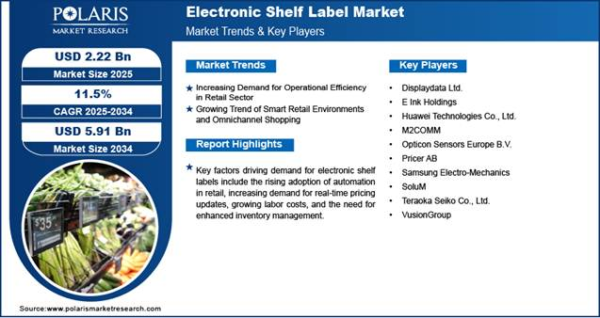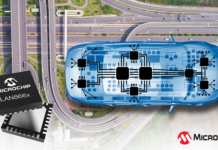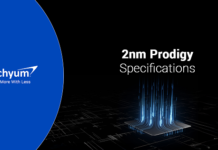
The retail industry is going digital, and one of the most effective innovations that is redefining in-store operations is the Electronic Shelf Label. These digital price tags replace traditional paper labels with electronic displays that automatically update product information, pricing, and promotions. ESL has become a cornerstone technology for modern retail environments, where efficiency, accuracy, and real-time data synchronization are increasingly emphasized. From supermarkets and convenience stores to outlets selling electronics and pharmaceuticals, retailers continue to adopt ESL systems to streamline operations, improve customer experiences, and enhance inventory management. As the shift toward omnichannel retailing intensifies, ESLs serve as a crucial bridge between physical and digital commerce.
What are Electronic Shelf Labels?
ESLs are small, digital devices usually based on e-paper or LCD, displaying product prices and information attached to retail shelves. Wirelessly connected to the central server, they allow retailers to update prices instantly at every location by changing the prices through cloud-based software. Thus, it saves the manual labor that is required to replace the paper tags, reduces pricing errors, and permits dynamic pricing strategies that reflect online market conditions in real time. Newer ESLs can display barcodes, QR codes, or promotional graphics, improving the interaction and visual appeal of shopping.
Did You Know?
The electronic shelf label (ESL) market size stood at USD 1.95 billion in 2024, according to the latest study by Polaris Market Research. The market is expected to grow at a CAGR of 11.5% from 2025 to 2034.
Key Technologies in ESL Systems
E-Paper Displays
With low power consumption, a wide viewing angle, and good visibility in various lighting conditions, e-paper technology remains the most utilized display medium in ESLs. Since these displays retain an image without the constant need for power, their applications in battery-operated devices allow them to run for years on a single charge.
Communication Technologies
ESL systems make use of robust wireless communication protocols to enable the synchronization of data across store servers and labels. While RF is the most common technology used today, BLE and NFC are increasingly being adopted due to faster update times and compatibility with mobile devices.
Battery and Energy Management
Advancements in ultra-low-power electronics and power-efficient battery systems enable ESLs to operate for up to 5–10 years, which drastically reduces maintenance costs and also the resultant downtime.
Electronic Shelf Label Segmentation by Display Size
Small (Up to 3 Inches)
The small-sized labels are ideal for smaller products and shelf edges, finding wide application in convenience stores and supermarkets where space is extremely valuable.
Medium (3–7 Inches)
These are used for larger items, electronics, and promotional displays. The size can accommodate detailed product information, images, and branding elements.
Large (Above 7 Inches)
These are usually applied to end-cap displays or to specific sections, such as fashion, electronics, or furniture. They support video and dynamic content for interactive merchandising.
Market Drivers
Rising Demand for Operational Efficiency
Retailers are continually under pressure to make their operations more efficient and cut labor costs. The electronic shelf label market automates many labor-intensive manual processes, freeing up staff to concentrate on customer service and sales rather than routine updates.
Growth of Omnichannel and Dynamic Pricing Models
With increased competition in e-commerce, brick-and-mortar stores have started using ESLs for dynamic pricing: aligning prices at a physical store with online offers in real time. This creates omnichannel consistency and builds customer trust.
Advancement in Display and Communication Technologies:
Improvements in e-paper display, wireless communication, and integration of IoT are driving innovation in ESL systems. These have increased the visibility, range, and responsiveness, which enable faster and more reliable updates.
Emerging Trends
Integration with AI and IoT Platforms: Modern ESLs are being integrated with AI-based analytics and IoT networks, which automate pricing decisions, track inventory levels, and predict consumer behavior. AI algorithms trigger automatic discounts or restocking alerts as patterns of sales emerge.
Adoption of NFC and QR-Based Customer Interaction: Retailers are embedding NFC chips and QR codes into ESLs, enabling shoppers to scan products with a smartphone and access reviews, nutritional facts, or personal recommendations to improve engagement and transparency.
Smart Shelves and Real-Time Analytics: Smart shelves can be made out of ESLs combined with weight sensors and cameras to track product movements and provide real-time stock visibility. This trend supports predictive inventory management and loss prevention.
5G-Enabled Retail Connectivity: As 5G networks spread, the electronic shelf lable market will equally benefit from increased data transmission speeds, enabling real-time updates even in the largest retail formats. This development will further enable integration with augmented reality-based in-store navigation and virtual promotions.
Conclusion
The electronic shelf label market symbolizes an important step forward toward the future of smart retail. ESLs bring efficiency in real-time pricing, increase internal operation efficiency, and are sustainable for the environment, hence reshaping the retail experience. Due to the continuous evolution of technology in terms of artificial intelligence, IoT, and 5G connectivity, ESLs will surely form part of intelligent retail ecosystems. Thus, retailers embracing such innovative technologies today reduce costs and errors, but most importantly set new standards in the dimensions of transparency, agility, and customer experience relevant in digital commerce times.

















